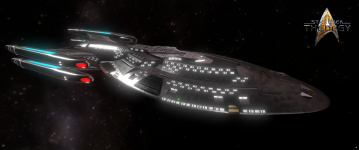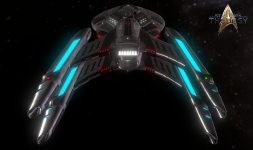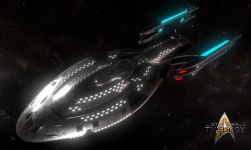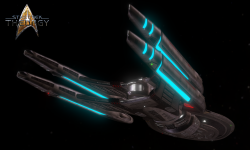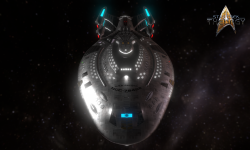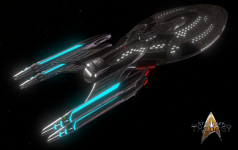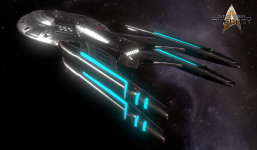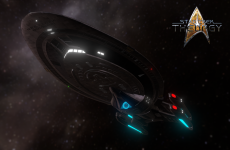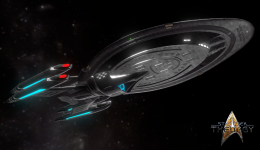USS Cayuga
From Star Trek: Theurgy Wiki
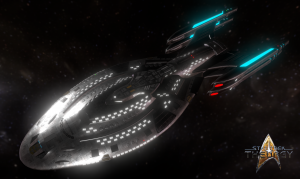
| |
| Vessel Name: | USS Cayuga |
| Registry: | NCC-78498 |
| Starship Class: | Iroquois-class |
| Starship Type: | Long Range Explorer |
| Status: | Unknown |
| Purpose: | Exploration & Scientific Research |
| Constructed: | San Francisco Fleet Yards & Utopia Planitia Fleet Yards |
| Commissioned: | January 18th, 2376 (2 years after the prototype, the USS Iroquois) |
| Dedication: | “Only those who risk going too far can possibly find out how far one can go.” - T.S. Eliot |
| Dimensions: |
|
| Mass: | 3,000,000 metric tons |
| Decks: | 17 |
| Standard Crew Complement | 150 |
| Maximum Cruising Speed |
Warp Factor 8.5 |
| Standard Cruising Speed | Warp Factor 7.5 |
| Armaments: |
|
| Defences: |
|
| Auxiliary Craft |
|
| Design: |
Auctor Lucan |
| 3D Model: |
Kalashnikov 3D |
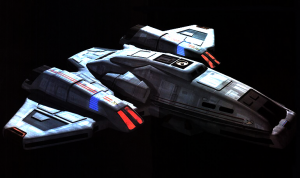
| |
The USS Cayuga (NCC-78498) was a late 24th century Federation Iroquois-class starship operated by Starfleet. As of March in 2381, there was no record available on its current location or crew complement. (Note: This ship has yet to make an appearance in the Star Trek: Theurgy story)
Starship Demonstration
History
By the mid-2370s, the success and failures of the Intrepid-class were clear to Starfleet. Her mechanically moving nacelles proved to be both a maintenance nightmare and unfitting for sustained speed at higher warp factors, so the development an upgraded long-range exploratory craft began. Thus, the Advanced Starship Design Bureau designed the next great explorer; the Iroquois-class. The name was picked in tribute to the Native Americans of centuries past, and because the Iroquois-class' improved warp geometry was partially based on the quad-nacelle Cheyenne-class.
The USS Iroquois, the first of its class, was launched in 2374 to great fanfare and was quickly seen by the Federation Science Council as a valuable resource. It was still small compared to the Galaxy-class, yet larger than the Intrepid, containing the best technology available to the United Federation of Planets as of its commissioning date. It was contemporary with the Prometheus-class, and they both shared some design characteristics.
The sleek curves of the Iroquois-class weren’t just a stylistic choice, they assisted the quad-geometry warp nacelles in producing a tight warp field over the starship with a steep and stable field gradient in even turbulent space-time conditions, giving the ships both an impressive warp acceleration and stability. These features, along with the vessels primary Class-9 warp drive and its secondary warp assembly allowed the class an impressive top speed and unmatched durability of warp 9.99 for 2 weeks. This achievement was made possible by the symmetry of the compact warp nacelle assembly. Not only did it use tetryon warp plasma like the Prometheus-class, but it also enabled the use of a redundancy cycle, which allowed the warp coils to be taken offline for mid-warp maintenance.
With these speeds being standard, it was deemed necessary to develop a customized navigation system, the RAV/ISHAK Mod 3a warp celestial guidance system, specifically designed to handle the ship's high warp capability. They were also equipped with the best technology in the Federation as of 2374, including the newest generation of multi-spectral subspace sensors linked into the most powerful shipboard computer yet in service in Starfleet. It would only be surpassed by the Vesta and Theurgy-class ships later in the 2370s'. This computing power was possible through a breakthrough in the use of bio-neural circuitry on the Intrepid-class, only refined in this new explorer, allowing the vessels’ computer to form information connections in a faster and more natural way, giving the main computer the unique ability to adapt to new and confusing situations as well as improvise solutions. This increased computer power allowed the Iroquois-class more automation than many Starfleet vessels, keeping the typical crew rosters down to between 130–150 officers and crew.
As it was a deep-space exploratory vessel, all Iroquois-class starships had an impressive amount of tactical systems as standard, the reasoning being that it would be operating far from any other allied starships and may need to defend itself against multiple attackers. The Iroquois-class had nine Type-XI phaser strips and four torpedo launchers (two forward, two aft). To further planetary exploration, all Iroquois-class vessels were assigned at leastone Argo-shuttle, four Type-9 and Type-9A shuttlecraft in addition to the aeroshuttle that was located on the ventral side of the primary hull, being a refit of the model that Intrepid had been fitted with in 2370.
For crew recreation, new high resolution holo-emitters and integrated replicator systems made holodecks power efficient and able to create permanent matter in the simulation to prevent continual holo-emitter use and degradation. These same holo-emitters were also installed in a limited-purpose ship-wide hologrid, allowing the Mk II Emergency Medical Hologram system (EMH) to assist medical personnel when they required it anywhere aboard the ship.
Since its sustained warp speeds were so considerable, Starfleet lauded the design as its new deep-space explorer, and mass production began in 2375.
Commissioned Iroquois-class Starships as of March 2381
- USS Iroquois NX-78494, Prototype
- USS Mohawk NCC-78495
- USS Seneca NCC-78496
- USS Oneida NCC-78497
- USS Cayuga NCC-78498
- USS Onondaga NCC-78499
Aerowing Shuttle
Mounted on the underside of the saucer section, the Aerowing rested in a recessed hatchway just aft of the ventral sensor array. The craft served in the capacity of a runabout aboard larger ships. In fact the Aerowing’s technology and design was based, in large part, on the Danube class runabout. The Aerowing provided a large secondary craft, long-range travel, and the protection, armament, and sensor capabilities beyond that of a standard auxiliary shuttle.
Facilities included two sleeping bunks and a standard runabout passenger cabin. A replicator and flight couches provided for the needs of the passengers and a two-person transporter allows for beaming of personnel or cargo when needed. Atmospheric flight capabilities allowed this shuttle type to land on planetary surfaces.
Gallery
Known Crew
These were the known crew of the USS Cayuga at the point of its mission in the Azure Nebula:
Commanding Officers
- Captain Anya Ziegler
Command Crew
- Executive Officer
- Commander Anderson West
- Second Officer
- Unknown
- Acting Chief Tactical Officer
- Junior Lieutenant Salem Martin
- Chief CONN Officer
- Unknown
- Chief Engineering Officer
- Unknown
- Chief Medical Officer
- Lieutenant Eli Barlow
- Chief Counselor
- Unknown
- Chief of Operations
- Unknown
- Chief Science Officer
- Unknown
- Chief Security Officer
- Lieutenant Winter Bannin
Other Known Crew
Unknown
